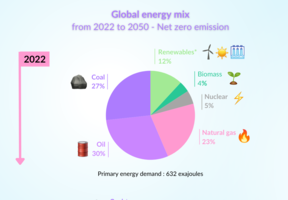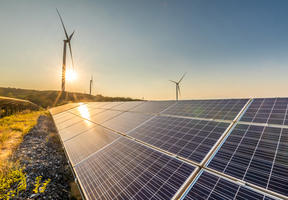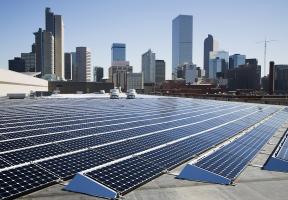Concentrated Solar Power Plants
10 min read
Concentrated solar (CSP) plants concentrate the Sun's rays to produce extremely high temperatures, and in turn generate . They differ from photovoltaic (PV) solar plants, which directly convert sunlight to electricity using photosensitive cells. Electricity is generated by transfer, solar radiation and thermodynamics - a good case study for physics and chemistry lessons.

© Stringer / Imaginechina / Imaginechina via AFP - Aerial view of the 100-megawatt molten salt solar power concentrated solar power (CSP) plant in Dunhuang city
As the name suggests, concentrated solar power plants use mirrors to concentrate the sunlight and heat a transfer fluid to a high temperature. This fluid, which can be air, water, oil, molten salt or organic liquids such as butane or propane, heats a network of water, which produces steam and drives a turbine, thereby generating electricity.
Depending on the method used to concentrate the Sun's rays, there are several types of plant, including:
- Solar power towers: Hundreds or thousands of mirrors mounted on the ground, known as heliostats, direct the sunlight toward the top of a tower that can be over 200 meters tall. The heliostats rotate to follow the Sun's course throughout the day. At the top of the tower, a receiver, inside which flows the (usually molten salt) transforms the sunlight into high temperatures. These plants require intense sunlight and vast areas of land. An example of the technology can be found at the 392-megawatt Ivanpah plant in California, which uses 173,500 heliostats.
- Parabolic trough power plants (PTPPs): Parallel rows of long parabolic mirrors known as troughs concentrate the Sun's heat on an axial tube, containing a heat transfer fluid, placed above each trough. The mirrors rotate on a horizontal axis, which enables them to follow the Sun's course. The temperature of the transfer fluid can reach up to 500°C. As with solar power towers, parabolic trough power plants operate best across vast areas in regions with intense sunlight. This technology is notably used in the 100-megawatt Shams power plant in the United Arab Emirates, which harnesses 258,000 parabolic mirrors over 2.5 square kilometers, and in the 160‑megawatt Noor 1 power plant in Morocco, where 500,000 mirrors cover an area of 4.8 square kilometers, or the equivalent of 600 soccer fields.
- Linear Fresnel power plants: Long, flat mirrors, mounted horizontally on trackers on the ground, capture the Sun's energy, which is reflected onto a linear receiver tube fixed parallel above the mirrors. Inside this tube, a transfer fluid is heated to temperatures of up to 500°C. The technology is named after the early 19th century French scientist, Augustin Fresnel, who invented the thick lens mounted on lighthouse beacons. The flat mirrors are much less expensive than parabolic mirrors, but optical performance is lower. This technology is used in the 12-megawatt Alba Nova plant in Ghisonaccia, Corsica.
- Parabolic dish power plants: The large parabolic dish of mirrors mounted on a structure that tracks the sun continuously throughout the day looks a lot like a satellite dish. It focuses sunlight into a central point just above the dish. Here, it meets a 1, which is powered by the rising pressure generated by a gas sealed inside a closed cylinder. Temperatures on the receiver can reach up to 1,000°C. The dishes are compact, independent units and therefore have a relatively small footprint. The performance of the plant is closely linked to the optical precision of the dish and the output of the Stirling engine. An example of the technology can be seen near Phoenix, Arizona, where, 60 parabolic dishes make up a 1.5-megawatt plant.
Several of these technologies can be combined in the same power plant, or even be associated with photovoltaic facilities.
A promising future
In 2021, world production of thermodynamic power plants did not exceed 15,000 GWh, whereas photovoltaic solar plants were producing over a million GWh, i.e. a of 1 to 70. The downside of thermodynamic power stations is that they are more costly and have a much larger footprint, but the is predicting strong development by 2050. One of the major advantages of concentrated solar power is being able to store the energy produced. Heat is much easier to store than electricity, especially if the heat transfer fluid is made of molten salts. They can retain heat for six to eight hours before it is converted into electricity. That means that heat stored at the hottest time of the day, can supply an electricity grid in the early evening, when consumption is at its peak. A photovoltaic plant however, is subject to variations in sunshine at a given time.
China takes the lead
For a long time, Spain and the United States were at the cutting edge of thermodynamic solar power, but since 2020, China, the Arab states of the Persian Gulf and several African countries such as Morocco have overtaken them. In 2024, the Emirate of Dubai is due to complete what should be the largest solar park in the world: MBR Solar Park is a combination of a (100 MW), three parabolic troughs (600 MW) and a photovoltaic farm (250 MW).
Sources:
- NREL Database SolarPACES






















